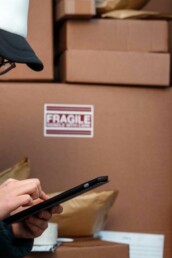3 Types of Logistics – Inbound, Outbound, and Reverse
Logistics is an important part of any business. It ensures that businesses deliver products and services on time and in a cost-effective manner. Simply put, logistics includes three main categories: inbound, outbound, and reverse logistics. Each of these categories has characteristics and processes, and businesses must understand them to operate successfully.

Inbound Logistics
Inbound logistics is the process of receiving and storing goods from suppliers and vendors. It involves managing the flow of materials from the point of origin to the point of use. It includes transportation, inventory management, warehousing, and order fulfillment. Here is a brief overview of aspects commonly considered inbound logistics activities:
- Sourcing and Procurement – Sourcing takes care of everything from finding suppliers, vetting & contracting them, and maintaining a healthy variety of vendors to cater to the organizational needs. Procurement involves procuring goods and services needed for the organization. See the differences between sourcing and procurement below:
- Ordering and Purchasing – Ordering and purchasing involves buying the correct quantity of goods in time for crucial business operations and sales
- Transportation – Selecting the transport method, speed, and carrier to move goods from vendors to their intended destination.
- Receiving – This process involves handling materials and goods as they arrive, including unloading and ensuring quality and quantity match the order.
- Storing – Once the goods are verified, they must be organized and stored. Typically this involves warehousing of some kind.
- Inventory Management – Another crucial aspect of the inbound logistics process is managing inventory, including adding raw materials, components, and ready-to-sell products to the inventory management system (IMS).
- Reverse Logistics – while this is its own type of logistics, it is also considered an inbound logistics activity because goods are added back into the supply chain. More on this later in the post
Inbound logistics is essential for businesses as it ensures that the right products are delivered to the right place at the right time. Furthermore, it supplies the company with the raw materials, goods, and services required to fulfill customer orders.

Outbound Logistics
Outbound logistics is the process of transporting and delivering goods to customers. It is the opposite of inbound logistics and involves activities such as order processing, picking, packing, and shipping. Outbound logistics focuses on the demand side of the supply-and-demand equation. In brief, some of the most vital outbound logistics processes include:
- Warehousing and Storage – Similar to inbound logistics, warehousing, and storage planning and design are necessary to fulfill orders quickly and accurately
- Picking and Packaging – As customer orders are received, the items are selected, packaged, and prepped for shipping.
- Outbound Transportation – This is the process whereby orders are delivered to the end user. Multiple aspects are in this category, including distribution channels, route optimization, and last-mile delivery.
Without a doubt, outbound logistics is essential for businesses as it ensures customers receive their orders on time and in perfect condition.

Reverse Logistics
Reverse logistics is essential for businesses to reduce costs associated with returns and allow companies to create a better customer experience. It involves every aspect of returning goods from customers to the business including; product inspection, repair, and replacement. With more than 20% of online purchases ending in a return or exchange, this type of logistic planning cannot be an afterthought. Companies that prioritize easy return policies and a fluid process for customers are earning trust and loyalty. What’s more, partnering with a 3PL provider that offers reverse logistics as a service is a great way to include this service without the headache of managing all the moving parts.
Beginner’s Guide to Third-Party Logistics (3PL)
The world of e-commerce is always changing, therefore understanding the roll of Third-Party Logistics is integral to keeping up. In light of this our beginner’s guide to third-party logistics (3PL) will delve into the essential aspects, offering insights into fulfillment services, warehousing, and much more.
Read More…
How a 3PL assists with the 3 types of logistics
A 3PL (Third-Party Logistics) provider helps companies manage their inbound, outbound, and reverse logistics operations. For inbound logistics, a 3PL can coordinate the transportation of goods from suppliers, manufacturers, and vendors to warehouses and distribution centers. For outbound logistics, a 3PL transports goods from warehouses to customers. Simply put, they receive products and components, store them, and ship them to the end customer. For reverse logistics, quality 3PL partners manage the return of goods from customers to suppliers or warehouses. In addition, a 3PL can help a company manage inventory levels and provide tracking and reporting services. Therefore, by leveraging their expertise, companies can streamline their supply chain operations, reduce costs, and improve customer service.
Overall, inbound, outbound, and reverse logistics are 3 types of logistics processes. These processes ensure products and services are delivered on time, cost-effective, and customer satisfaction. Businesses must understand and manage these processes to be successful. Talk to a friendly agent today to see how Falcon Fulfillment can assist with your logistics needs.
If you’re ready to start the transition or have questions, contact us to learn more about our services.
Let’s Talk!





